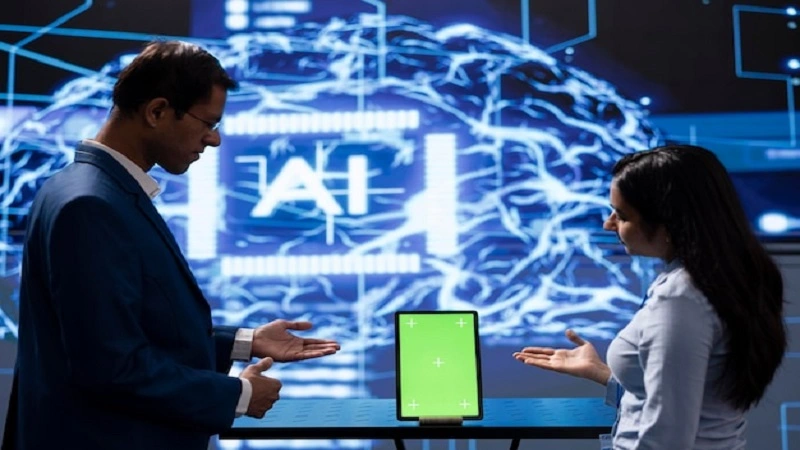In our modern, always-connected world, the demand for uninterrupted digital interaction has never been greater. With the explosion of smartphones, laptops, and smart devices, we are continuously surrounded by technology. This constant interaction, though convenient, can overwhelm us and lead to issues such as stress, anxiety, and burnout. Enter the concept of a The Intersection of AI and Digital Detox, where individuals consciously disconnect from their devices to recharge and regain balance.
But paradoxically, the very technology contributing to this overload—artificial intelligence (AI)—may also hold the key to managing it. AI, often seen as a tool for enhancing productivity and connectivity, is now being repurposed to help users establish boundaries and healthier relationships with their digital devices. Could AI help facilitate the detox we all desperately need? In this article, we explore this intriguing intersection and look at how AI is playing a role in fostering a balanced digital lifestyle.
What is The Intersection of AI and Digital Detox?
A digital detox refers to intentionally stepping away from digital devices like smartphones, computers, tablets, and social media platforms for a certain period. The goal is to reduce the negative impact of excessive technology use on our mental, emotional, and physical well-being.
In an age dominated by constant notifications, endless scrolling, and non-stop online interactions, many individuals feel overwhelmed by their screen time. Studies have linked excessive digital usage to problems such as sleep disturbances, reduced productivity, and mental health issues like anxiety and depression. A digital detox gives individuals an opportunity to recalibrate, refocus, and reconnect with the offline world.
The Rising Demand for Digital Detox
The idea of a digital detox is more important now than ever. On average, people spend several hours a day on their phones and devices, much of it devoted to social media or entertainment platforms. This trend shows no sign of slowing down, and with the increasing integration of AI into daily life, the line between personal and digital space is becoming blurred.
By taking a break from technology, individuals can enjoy better mental clarity, improved focus, enhanced creativity, and a healthier balance between work and life. Digital detoxes have been proven to improve well-being, yet disconnecting from technology is easier said than done.
The Role of The Intersection of AI and Digital Detox
While it may seem ironic, AI offers promising solutions to help users disconnect and manage their digital habits. By analyzing behaviors, guiding mindfulness, and managing notifications, AI can act as a digital wellness coach, helping users find balance in a tech-driven world.
1. AI-Powered Tools for Managing Screen Time
One of the most straightforward ways AI can help us disconnect is by offering smart insights into our screen time. AI-powered apps like RescueTime, StayFree, and Moment track usage patterns across devices. They offer insights into where we spend most of our time, whether on social media, email, or productivity apps.
Using algorithms, these apps can offer personalized suggestions to reduce screen time. They analyze when and how we use our devices, and through machine learning, can predict when we are most likely to fall into “mindless scrolling” or other unproductive habits. By delivering real-time feedback, AI empowers users to make conscious choices about their digital usage.
For example, Apple’s Screen Time feature and Google’s Digital Wellbeing suite use AI-driven technology to provide insights into screen usage patterns. They allow users to set limits on app usage, encourage breaks, and even set “downtime” when certain apps are restricted.
2. AI as a Mindfulness and Wellness Coach
The fast pace of life in the digital era often leaves little room for introspection and mental well-being. Fortunately, AI-powered mindfulness apps like Headspace, Calm, and Simple Habit are using AI to help users cultivate mindfulness practices.
By guiding users through meditation and breathing exercises, these apps help to reduce the mental strain caused by continuous tech engagement. AI helps personalize these experiences, analyzing the user’s progress over time to tailor sessions based on specific stressors or areas of focus. For instance, the AI behind Headspace can recommend certain types of meditations based on the time of day, user activity, and even emotional states.
These apps work like a wellness coach in your pocket, encouraging periods of mental clarity and reflection, away from the digital noise. The integration of AI allows for highly customized, data-driven mindfulness experiences, helping users to disconnect, de-stress, and re-center themselves.
3. Smart Notifications and Disruption Management
Notifications are one of the main culprits in driving our excessive digital engagement. Every ping or alert from social media, messaging apps, or email brings us back into the digital world, making it hard to disconnect.
AI can play a critical role in managing these disruptions. By prioritizing notifications and determining which ones require immediate attention, AI helps reduce notification fatigue. For instance, apps like Boomerang for Gmail use AI to categorize emails, sending important ones through immediately while delaying less critical communications.
Similarly, Google’s Digital Wellbeing tools employ AI to suggest periods of “Do Not Disturb” and quiet modes, enabling users to enjoy uninterrupted time for focus, relaxation, or sleep. These tools ensure that users stay connected to important notifications without being bombarded by irrelevant ones, creating healthier boundaries around device usage.
AI’s Contribution to Digital Detox in the Workplace
In the corporate world, where productivity and constant communication are paramount, the idea of a digital detox may seem impossible. However, AI has started playing a pivotal role in promoting employee wellness and work-life balance.
1. AI and Work-Life Balance
Remote work and the blending of personal and professional life have led to higher stress levels and digital overload for many employees. AI-driven tools such as Microsoft Viva and Slack’s AI integrations now offer features to promote a balanced work life. By analyzing activity patterns, AI can suggest optimal times for employees to take breaks, schedule “focus hours,” and even encourage logging off at the end of the workday.
AI can detect signs of overwork through metrics like email frequency or active hours and gently remind employees to pause, encouraging healthier habits. This helps businesses reduce burnout and fosters better overall productivity.
2. HR Tools for Wellness and Mental Health
Companies have started integrating AI into HR systems to track employee wellness and promote mental health initiatives. AI-driven platforms like Workhuman and BetterUp offer personalized mental health resources, encouraging employees to practice digital detoxes through mindfulness exercises, relaxation techniques, and well-being reminders.
These platforms use AI to monitor employee behavior patterns, detecting burnout or stress early and providing tailored solutions to combat it. This kind of technology helps businesses foster a culture that values mental health, digital balance, and long-term well-being.
Challenges of Using AI for Digital Detox
Despite the numerous advantages, there are inherent challenges when it comes to relying on AI for managing digital detox.
1. Over-Reliance on Technology
Ironically, using technology to take a break from technology creates a contradiction. While AI can help manage our screen time, relying too heavily on it may erode our sense of self-discipline and self-awareness. Rather than consciously deciding to disconnect, users might depend solely on AI prompts, leading to a loss of intuitive control over digital habits.
2. Privacy and Data Security Risks
AI-driven digital wellness apps require access to large amounts of personal data, such as device usage patterns, app preferences, and even emotional or mental health data. This raises concerns around privacy and the potential for misuse of sensitive information. Users need to be cautious about which apps they use and understand how their data is stored and protected.
The Future of AI and Digital Detox
The relationship between AI and digital detox is still evolving, but its potential is undeniable. As AI technologies advance, we are likely to see more sophisticated tools aimed at promoting digital wellness, guiding users toward healthier tech habits, and ultimately fostering a better balance between online and offline life.
However, to truly disconnect and reap the benefits of a digital detox, the key lies in using AI as a guide rather than a crutch.
Conclusion
The intersection of AI and digital detox offers a powerful solution to one of the most pressing issues of our time: technology overload. While AI is often associated with enhancing connectivity and productivity, it also presents opportunities to help us disconnect, manage screen time, and practice mindfulness. By leveraging AI wisely and maintaining a conscious approach to our tech habits, we can strike a healthier balance in our digital lives.
you may also like to read:


